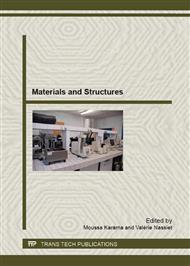[1]
G.S. Campbell and R. Lahey: International Journal of Fatigue, Vol. 6 (1984), p.25.
Google Scholar
[2]
W.Z. Zhuang and N.S. Swansson: Thermo-mechanical fatigue life prediction: a critical review. Airframes and engines division/aeronautical and maritime research laboratory, DSTO-TR-0609, (1998).
Google Scholar
[3]
G. Thomas, J. Bressers and D. Raynor: Low-Cycle Fatigue and Life Prediction Methods. High Temperature Alloys for Gas Turbines, edited by R. Brunetaud, D. Riedel Publishing Co., Netherlands, (1982), p.291.
DOI: 10.1007/978-94-009-7907-9_12
Google Scholar
[4]
R. Bill, M. Verrilli and G.R. Halford: A Preliminary study of the Thermo-Mechanical Fatigue of Polycrystalline MAR M-200, NASA TP-2280, AVSCOM TR 83-C-6, (1984).
Google Scholar
[5]
R. Neu and H. Sehitoglu: Met. Trans. A, 20A (1989), p.1755.
Google Scholar
[6]
S.P. Brookes: Thermo-mechanical fatigue behaviour of the near- γ -titanium aluminide alloy TNB-V5 under uniaxial and multiaxial loading (BAM Bundesanstalt für Materialforschung und Prüfung, Germany, 2009).
Google Scholar
[7]
G.R. Halford, S. Manson, B. Prillhofer, G. Winter and W. Eichlseder: Life prediction of thermal-mechanical fatigue using strain range partitioning, thermal fatigue of materials and components. ASTM STP 612, (1976), p.239.
DOI: 10.1520/stp27895s
Google Scholar
[8]
N. Moёs, J.E. Dolbow and T. Belytschko: International Journal for Numerical Methods in Engineering, Vol.46 (1999), p.131.
Google Scholar
[9]
B.L. Karihaloo and Q.Z. Xiao: Comp & Struct, Vol. 81 (2003), p.119.
Google Scholar
[10]
Y. Abdelaziz and A. Hamouine: Comp & Struct, Vol. 86 (2008), p.1141.
Google Scholar
[11]
S. Mohammadi: Extended finite element method. Oxford: Blackwell Publishing (2008).
Google Scholar
[12]
Hibbitt, Karlsson & Sorensen, Inc: ABAQUS/Standard User's Manual, v. 6.5 (Pawtucket, Rhode Island 2004).
Google Scholar
[13]
J. Shi, D. Chopp, J. Lua, N. Sukumar and T. Belytschko: Engineering Fracture Mechanics, Vol. 77 (2010), p.2840.
DOI: 10.1016/j.engfracmech.2010.06.009
Google Scholar
[14]
G.A. Swanson, I. Linask, D.M. Nissley, P.P. Norris, T.G. Meyer and K.P. Walker: Life prediction and constitutive models for engine hot section, Anisotropic materials program. NASA contractor report 174952 (1986).
Google Scholar
[15]
T. Gocmez, A. Awarke and S. Pishinger: International Journal of Fatigue, Vol. 32 (2010), p.769.
Google Scholar
[16]
J. Lemaitre and J.L. Chaboche: Mechanics of solid materials, edited by Cambridge University Press, Cambridge, 1990.
Google Scholar
[17]
P.C. Paris, M.P. Gomez and W.E: Anderson: The Trend of Engineering, Vol. 13 (1961), p.9.
Google Scholar
[18]
H. Sehitoglu: Thermo-Mechanical Fatigue Life Prediction Methods. Advances in Fatigue Lifetime Predictive Techniques, ASTM STP 1122, (1992), p.47.
DOI: 10.1520/stp24152s
Google Scholar
[19]
H.J. Christ, A. Jung, H.J. Maier and R. Teteruk: Sadhana, Vol. 28 (2003), p.147.
Google Scholar
[20]
R.P. Skelton: Material Science Technology, Vol. 9 (1993), p.1001.
Google Scholar
[21]
A. De Andres, J. Perez and M. Ortiz : International Journal of Solids and Structures, Vol. 36 (1999), p.2231.
Google Scholar
[22]
G.Q. Sun and D.G. Shang: Materials and Design, Vol. 31 (2010), p.126.
Google Scholar
[23]
I. Babuska and J.M. Melenk: International Journal for Numerical Methods in Engineering, Vol. 40 (1998), p.727.
Google Scholar
[24]
T. Belytschko, R. Gracie and G. Ventura: Modeling and Simulation in Materials Science and Engineering, Vol. 17 (2009), p.1.
Google Scholar
[25]
N. Sukumar, J.E. Dolbow, A. Devan, J. Yvonnet, F. Chinesta, D. Ryckelynck, P. Lorong, I.Alfaro, M.A. Martίnez, E. Cueto and M. Doblarès: International Journal of Forming Processes, Vol.8 (2005), p.409.
DOI: 10.3166/ijfp.8.409-427
Google Scholar
[26]
N. Sukumar, N. Moёs, B. Moran and T. Belytschko: International Journal for Numerical Methods in Engineering, Vol. 48 (2000), p.1549.
Google Scholar
[27]
A. Zamani and M.R. Eslami: International Journal of Solids and Structures, Vol. 47 (2010), p.1392.
Google Scholar
[28]
F. Erdogan and G.C. Sih: Journal of Basic Engineering, Vol. 85 (1963), p.519.
Google Scholar


